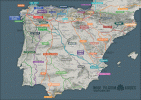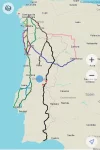- Time of past OR future Camino
- Some in the past; more in the future!
Edit: the article giving an overview of the Portuguese caminos is finished and published here:
The Camino de Santiago in Portugal
The original first post in this thread follows.
---
I am in the early stages of writing an article about the various Camino de Santiago routes in Portugal. As part of this article, I am going to include an 'at a glance' section for each route with basic details (start and end points, distance, approximate stages etc) and as part of this I thought about including pros and cons for each route.
To start with I have included two pros and two cons for each route (I'm open to more but prefer to have the same number for each route for consistency). There is a certain degree of subjectivity in these, of course, and since I haven't walked all of the routes I am going by what I've read in some cases, so I ask for your help in rounding out the lists.
Any feedback, criticism, additions, suggestions or other comments are most welcome!
Caminho Português Central (from Porto)
Pros: Good pilgrim infrastructure, Variante Espiritual
Cons: Walking on cobblestones, possibly too much pilgrim traffic
Caminho Português Coastal
Pros: Coastal views, several options for rejoining the central route
Cons: Not a traditional route, some coastal towns are touristy
Caminho Português (from Lisbon)
Pros: More immersion in Portugal, historic towns of Santarém, Tomar and Coimbra
Cons: Some unattractive road walking, lack of pilgrim infrastructure before Porto
Caminho Português Interior
Pros: Spectacular scenery, historical route
Cons: Lots of ups and downs, inconsistent way-marking
Caminho de Torres
Pros: Douro Valley, historic cities of Guimarães and Braga
Cons: A lot of road walking, lack of pilgrim infrastructure
Caminho da Geira e dos Arrieros
Pros: National Park Peneda-Gerês, welcoming pilgrim atmosphere
Cons: Inconsistent way-marking, lack of pilgrim infrastructure
Caminho Nascente
Pros: Mostly countryside walking, many historic towns and castles
Cons: Lack of pilgrim infrastructure, oppressive heat in summer
Caminho Central
Pros: Easy-to-reach starting point, joins standard CP in Santarém
Cons: Lack of pilgrim infrastructure, oppressive heat in summer
Caminho da Raia
Pros: Several historic towns including Marvão, road less travelled
Cons: Lack of pilgrim infrastructure, way-marking incomplete as of 2021
Camino Zamorano Portugués (Via de la Plata Portugués)
Pros: Historic town of Bragança, detour to see San Pedro de la Nave church
Cons: Lots of ups and downs, lack of English spoken in rural Portuguese sections
The Camino de Santiago in Portugal
The original first post in this thread follows.
---
I am in the early stages of writing an article about the various Camino de Santiago routes in Portugal. As part of this article, I am going to include an 'at a glance' section for each route with basic details (start and end points, distance, approximate stages etc) and as part of this I thought about including pros and cons for each route.
To start with I have included two pros and two cons for each route (I'm open to more but prefer to have the same number for each route for consistency). There is a certain degree of subjectivity in these, of course, and since I haven't walked all of the routes I am going by what I've read in some cases, so I ask for your help in rounding out the lists.
Any feedback, criticism, additions, suggestions or other comments are most welcome!
Caminho Português Central (from Porto)
Pros: Good pilgrim infrastructure, Variante Espiritual
Cons: Walking on cobblestones, possibly too much pilgrim traffic
Caminho Português Coastal
Pros: Coastal views, several options for rejoining the central route
Cons: Not a traditional route, some coastal towns are touristy
Caminho Português (from Lisbon)
Pros: More immersion in Portugal, historic towns of Santarém, Tomar and Coimbra
Cons: Some unattractive road walking, lack of pilgrim infrastructure before Porto
Caminho Português Interior
Pros: Spectacular scenery, historical route
Cons: Lots of ups and downs, inconsistent way-marking
Caminho de Torres
Pros: Douro Valley, historic cities of Guimarães and Braga
Cons: A lot of road walking, lack of pilgrim infrastructure
Caminho da Geira e dos Arrieros
Pros: National Park Peneda-Gerês, welcoming pilgrim atmosphere
Cons: Inconsistent way-marking, lack of pilgrim infrastructure
Caminho Nascente
Pros: Mostly countryside walking, many historic towns and castles
Cons: Lack of pilgrim infrastructure, oppressive heat in summer
Caminho Central
Pros: Easy-to-reach starting point, joins standard CP in Santarém
Cons: Lack of pilgrim infrastructure, oppressive heat in summer
Caminho da Raia
Pros: Several historic towns including Marvão, road less travelled
Cons: Lack of pilgrim infrastructure, way-marking incomplete as of 2021
Camino Zamorano Portugués (Via de la Plata Portugués)
Pros: Historic town of Bragança, detour to see San Pedro de la Nave church
Cons: Lots of ups and downs, lack of English spoken in rural Portuguese sections
Last edited:





















